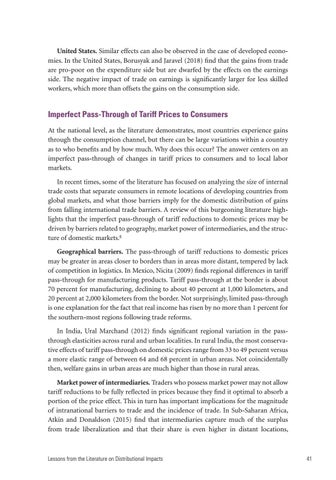United States. Similar effects can also be observed in the case of developed economies. In the United States, Borusyak and Jaravel (2018) find that the gains from trade are pro-poor on the expenditure side but are dwarfed by the effects on the earnings side. The negative impact of trade on earnings is significantly larger for less skilled workers, which more than offsets the gains on the consumption side.
Imperfect Pass-Through of Tariff Prices to Consumers At the national level, as the literature demonstrates, most countries experience gains through the consumption channel, but there can be large variations within a country as to who benefits and by how much. Why does this occur? The answer centers on an imperfect pass-through of changes in tariff prices to consumers and to local labor markets. In recent times, some of the literature has focused on analyzing the size of internal trade costs that separate consumers in remote locations of developing countries from global markets, and what those barriers imply for the domestic distribution of gains from falling international trade barriers. A review of this burgeoning literature highlights that the imperfect pass-through of tariff reductions to domestic prices may be driven by barriers related to geography, market power of intermediaries, and the structure of domestic markets.6 Geographical barriers. The pass-through of tariff reductions to domestic prices may be greater in areas closer to borders than in areas more distant, tempered by lack of competition in logistics. In Mexico, Nicita (2009) finds regional differences in tariff pass-through for manufacturing products. Tariff pass-through at the border is about 70 percent for manufacturing, declining to about 40 percent at 1,000 kilometers, and 20 percent at 2,000 kilometers from the border. Not surprisingly, limited pass-through is one explanation for the fact that real income has risen by no more than 1 percent for the southern-most regions following trade reforms. In India, Ural Marchand (2012) finds significant regional variation in the passthrough elasticities across rural and urban localities. In rural India, the most conservative effects of tariff pass-through on domestic prices range from 33 to 49 percent versus a more elastic range of between 64 and 68 percent in urban areas. Not coincidentally then, welfare gains in urban areas are much higher than those in rural areas. Market power of intermediaries. Traders who possess market power may not allow tariff reductions to be fully reflected in prices because they find it optimal to absorb a portion of the price effect. This in turn has important implications for the magnitude of intranational barriers to trade and the incidence of trade. In Sub-Saharan Africa, Atkin and Donaldson (2015) find that intermediaries capture much of the surplus from trade liberalization and that their share is even higher in distant locations,
Lessons from the Literature on Distributional Impacts 41
